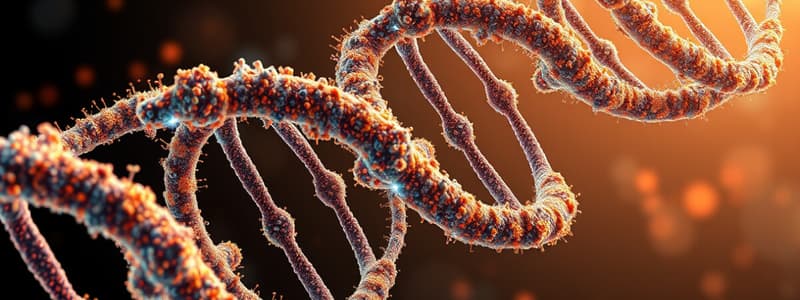Podcast
Questions and Answers
DNA replication occurs in the ______ during interphase of mitosis and meiosis
DNA replication occurs in the ______ during interphase of mitosis and meiosis
nucleus
Energy (______) and the enzyme DNA polymerase are needed for DNA replication
Energy (______) and the enzyme DNA polymerase are needed for DNA replication
ATP
The double helix opens - it untwists and unzips (hydrogen bonds broken by ______) prior to replication
The double helix opens - it untwists and unzips (hydrogen bonds broken by ______) prior to replication
enzymes
Each new DNA molecule is (i) half new and half ______, (ii) identical to the original and each other
Each new DNA molecule is (i) half new and half ______, (ii) identical to the original and each other
Signup and view all the answers
Each new piece of DNA rewinds to form a ______ helix
Each new piece of DNA rewinds to form a ______ helix
Signup and view all the answers
DNA is a polymer made up of thousands of repeating ______.
DNA is a polymer made up of thousands of repeating ______.
Signup and view all the answers
The basic shape of DNA is a double ______.
The basic shape of DNA is a double ______.
Signup and view all the answers
The sides of the DNA ladder consist of alternating deoxyribose sugar and ______ groups.
The sides of the DNA ladder consist of alternating deoxyribose sugar and ______ groups.
Signup and view all the answers
James Watson and Francis Crick discovered the molecular structure of DNA in ______.
James Watson and Francis Crick discovered the molecular structure of DNA in ______.
Signup and view all the answers
Chromosomes are composed of two strands called ______ held together by a structure called the centromere.
Chromosomes are composed of two strands called ______ held together by a structure called the centromere.
Signup and view all the answers
When chromosomes are spread out, they are called ______.
When chromosomes are spread out, they are called ______.
Signup and view all the answers
Before division, cells become shorter and thicker as the DNA coils around ______.
Before division, cells become shorter and thicker as the DNA coils around ______.
Signup and view all the answers
Each gene has a specific position on a chromosome called the ______.
Each gene has a specific position on a chromosome called the ______.
Signup and view all the answers
Most genes have two different options, called ______.
Most genes have two different options, called ______.
Signup and view all the answers
Alleles can be either dominant or ______.
Alleles can be either dominant or ______.
Signup and view all the answers
Study Notes
DNA Structure
- Rungs of DNA consist of complementary bases held by hydrogen bonds.
- Four nitrogenous bases: Adenine (A), Thymine (T), Guanine (G), and Cytosine (C).
- Base pairing rules: Adenine pairs exclusively with Thymine; Guanine pairs with Cytosine.
DNA Replication
- Occurs in the nucleus during interphase of mitosis and meiosis.
- Requires energy (ATP) and enzyme DNA polymerase.
- Double helix unzips and untwists as hydrogen bonds break.
- New nucleotides enter from the cytoplasm, forming complementary strands.
- Each new DNA molecule consists of one old and one new strand, creating identical copies.
- Essential for accurately passing genetic information to the next generation.
Ribonucleic Acid (RNA) Structure
- RNA contains ribose sugar; Thymine is replaced by Uracil (U).
- RNA is single-stranded, unlike double-stranded DNA.
- Types of RNA:
- Messenger RNA (mRNA): Transmits information from DNA to ribosomes for protein synthesis.
- Ribosomal RNA (rRNA): Proteins and major structural component of ribosomes.
Heredity and Gene Expression
- Heredity refers to the transmission of traits from one generation to another through genes.
- Example: Brown-eyed parents producing brown-eyed children.
- Gene: Segment of DNA coding for a protein or characteristic.
- Gene expression: Process of using gene information to produce traits or proteins.
- Dominance example: Brown eye gene is dominant over blue eye gene.
Chromosome Structure
- Each gene has a specific location called a locus; multiple forms called alleles can be dominant or recessive.
- Chromosome structure consists of two chromatids linked by a centromere.
- Chromatin is the relaxed form of DNA combined with proteins; coils into chromosomes during cell division.
- Chromosomes are organized lengths of DNA wrapped around histones.
DNA Discovery
- James Watson and Francis Crick discovered DNA's double helix structure in 1951.
- DNA is a polymer made up of repeating nucleotide units.
- The scaffold consists of alternating deoxyribose sugar and phosphate groups.
Transfer RNA (tRNA)
- tRNA collects and delivers specific amino acids to ribosomes for protein assembly.
DNA Profiling
- DNA profiling creates a unique pattern of DNA bands for individual identification.
- Process involves:
- Extraction of DNA from cells.
- Amplification of low DNA quantities using polymerase chain reaction (PCR).
- Cutting DNA with restriction enzymes at specific sequences.
- Separation of DNA fragments via gel electrophoresis.
- Visualization on a nylon membrane using radioactive probes.
- Applications include criminal identification and paternity testing.
Genetic Screening
- Checks for the presence or absence of specific alleles or genes.
- Uses labelled DNA sequences to detect specific genes.
- Helps identify inheritable diseases like cystic fibrosis and hemochromatosis.
Studying That Suits You
Use AI to generate personalized quizzes and flashcards to suit your learning preferences.
Related Documents
Description
Test your knowledge on the structure of DNA, the complementary base pairing, and the process of DNA replication. This quiz covers key concepts such as nucleotide composition and the role of enzymes during replication.




